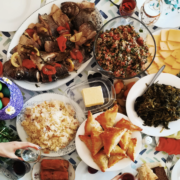Discover The Joys Of Cooking Healthful Foods
Cooking gets a bad rap. When I encourage my clients to cook real food, I hear a lot of excuses like it’s time-consuming, difficult, or inconvenient. Would you believe that Americans spend more time watching cooking shows on TV than actually cooking in their kitchens? Many are living on processed and fast foods, and our younger generations don’t know how to cook. I’d like to help you discover the joys of cooking healthful foods.
Did you cook in the kitchen with your mother or grandmother? Cooking is an act of love that strengthens relationships and can support wellness. The process of cooking teaches life skills to your children who need to know how to follow a recipe and create a meal that offers balanced nutrition. Cooking is also an important first step in good digestion and nourishing your body.
Whatever your experience in the kitchen, these strategies simplify the process and encourage healthful cooking in a way that even the busiest novice can enjoy.
Make The Kitchen A Welcoming Room
My father was a Marine Corps officer and my parents often entertained guests. I always found it interesting that despite having lots of space in our home for people to gather, a number of our guests always congregated in the kitchen. Many people recognize the kitchen as the place for nourishing the body. For many of us, it is also a place where relationships are nourished.
The kitchen can also provide a valuable classroom where your kids can learn and practice skills that will serve them for their lifetime. Working alongside you also provides a relaxed time to talk about a wide range of subjects that interest them, further strengthening your bond together.
Keep Staples On Hand
While fresh vegetables from the produce aisle are ideal, stocking up on frozen berries and vegetables can provide longer-lasting alternatives for easy meals.
Keeping nuts, nut butters, rice, and quinoa in your pantry can also provide snacks and the foundations for meals. Grains like rice and quinoa can even be cooked in bulk as you prepare a recipe and the extra saved in the refrigerator to make preparation of the next meal faster.
Examine Your Time
Lack of time is the biggest excuse my clients give for not cooking at home. Yet, I’m willing to bet that you have more time than you realize. If you keep a journal for several days or a week of all your activities – yes, detail is important here – you can examine where your time could be better spent. Perhaps you need to reduce your scrolling time, or shut off that cooking show, and reclaim some time for cooking.
Get The Whole Family Involved
Here’s a way to reduce the time you need while also building bonds with your kids and teaching them valuable skills. It may mean dragging them away from video games to help you measure ingredients or chop veggies or set the table. Make a point of choosing menus and trying recipes together. Then celebrate the food you have prepared.
Let Yourself Make Mistakes
As you embark on this new adventure in the kitchen, don’t aim for perfection. It’s okay if your food doesn’t look like the picture. Consider this experimentation and practice. Choose simpler recipes with few ingredients and as you become more practiced and confident go for the more complex recipes.
Could you use some added inspiration? Gather the family and watch Fed Up, a family-friendly documentary that explores what has gone wrong in our modern food industry and how we can fix it. Many have found this to be the “fire” they needed to get them back in the kitchen to cook.
Buying real food and cooking it yourself is the first step in transforming your health. Making it a family affair can help both you and your family discover the joys of cooking healthful foods and strengthening your bond as a family.










